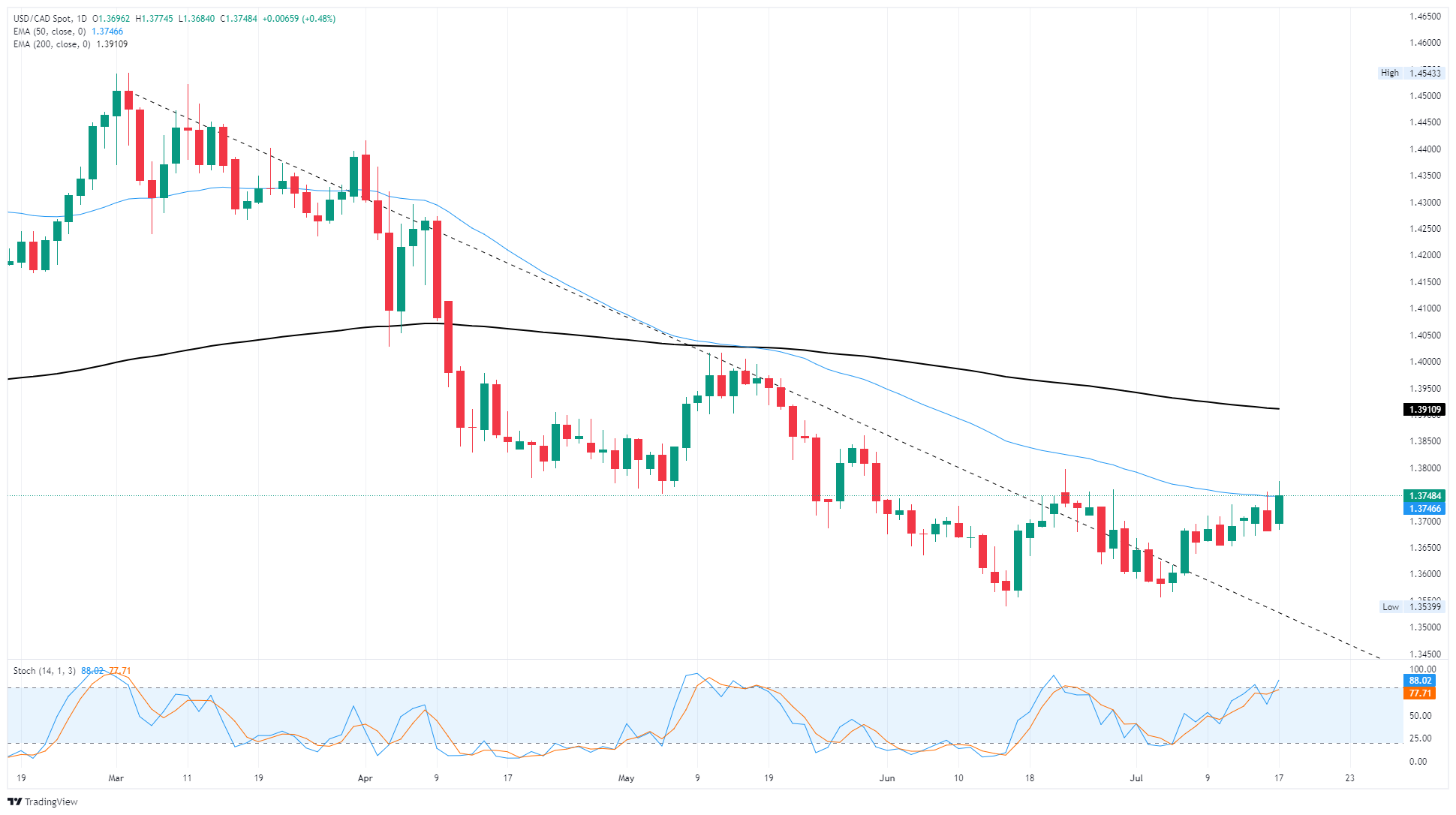Canadian Dollar loses ground against recovering Greenback
- The Canadian Dollar shed more weight on Thursday.
- Investors are bidding the US Dollar back up after an early-week plunge.
- US data and headlines dominated the newsfeeds as Canadian factors wane.
The Canadian Dollar (CAD) shed further weight on Thursday, falling to its lowest bids against the US Dollar (USD) in nearly a month as Greenback-based market flows reverse course back into the USD. Upbeat United States (US) economic data bolstered market confidence, but the odds of an accelerated pace of Federal Reserve (Fed) rate cuts still remains limited, keeping the Greenback on the high side.
Low-tier Canadian economic data took a backseat, with the Loonie data docket exhausted following this week’s Consumer Price Index (CPI) inflation acceleration. The Bank of Canada (BoC) is increasingly unlikely to enact further rate cuts, leaving the CAD at the mercy of broad-market flows.
Daily digest market movers: US PPI upswing sparks renewed investor confidence
- The Canadian Dollar fell for a second straight day against the Greenback amid a growing USD resurgence.
- USD/CAD tested new intraday highs above 1.3750 for the first time in almost a month.
- US Producer Price Index (PPI) inflation figures came in cooler than expected in June, bolstering market hopes that tariffs will have a lesser impact than many expected or feared.
- However, critical factors limit upside potential for PPI impact: imported goods that are subject to tariffs are overwhelmingly excluded from the PPI basket.
- Key US consumer sentiment indicators are due on Friday, and will dominate investor sentiment to round out the week.
Canadian Dollar price forecast
Renewed weakness in the Canadian Dollar is owing entirely to fresh upward momentum behind the Greenback, however the net effect is the same: USD/CAD is back into three-week highs, and knocking on the 50-day Exponential Moving Average (EMA) near 1.3755 for the first time since April.
The pair is extending a technical recovery bolstering the Greenback, dragging USD/CAD back up the charts from a messy double-bottom pattern cooked into the chart paper near the 1.3600 region.
USD/CAD daily chart

Canadian Dollar FAQs
The key factors driving the Canadian Dollar (CAD) are the level of interest rates set by the Bank of Canada (BoC), the price of Oil, Canada’s largest export, the health of its economy, inflation and the Trade Balance, which is the difference between the value of Canada’s exports versus its imports. Other factors include market sentiment – whether investors are taking on more risky assets (risk-on) or seeking safe-havens (risk-off) – with risk-on being CAD-positive. As its largest trading partner, the health of the US economy is also a key factor influencing the Canadian Dollar.
The Bank of Canada (BoC) has a significant influence on the Canadian Dollar by setting the level of interest rates that banks can lend to one another. This influences the level of interest rates for everyone. The main goal of the BoC is to maintain inflation at 1-3% by adjusting interest rates up or down. Relatively higher interest rates tend to be positive for the CAD. The Bank of Canada can also use quantitative easing and tightening to influence credit conditions, with the former CAD-negative and the latter CAD-positive.
The price of Oil is a key factor impacting the value of the Canadian Dollar. Petroleum is Canada’s biggest export, so Oil price tends to have an immediate impact on the CAD value. Generally, if Oil price rises CAD also goes up, as aggregate demand for the currency increases. The opposite is the case if the price of Oil falls. Higher Oil prices also tend to result in a greater likelihood of a positive Trade Balance, which is also supportive of the CAD.
While inflation had always traditionally been thought of as a negative factor for a currency since it lowers the value of money, the opposite has actually been the case in modern times with the relaxation of cross-border capital controls. Higher inflation tends to lead central banks to put up interest rates which attracts more capital inflows from global investors seeking a lucrative place to keep their money. This increases demand for the local currency, which in Canada’s case is the Canadian Dollar.
Macroeconomic data releases gauge the health of the economy and can have an impact on the Canadian Dollar. Indicators such as GDP, Manufacturing and Services PMIs, employment, and consumer sentiment surveys can all influence the direction of the CAD. A strong economy is good for the Canadian Dollar. Not only does it attract more foreign investment but it may encourage the Bank of Canada to put up interest rates, leading to a stronger currency. If economic data is weak, however, the CAD is likely to fall.

